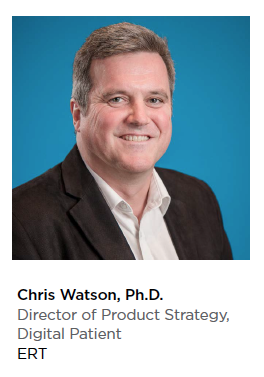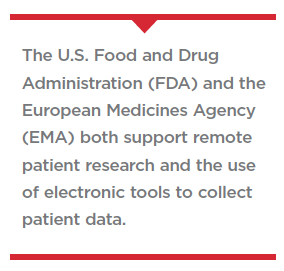 In its list of “Top 10 Strategic Trends for 2018," Gartner, Inc., notes that the digital and physical worlds are becoming more closely aligned. This phenomenon is certainly observable in clinical research, as technology is supporting more effective remote research through the use of electronic clinical outcome assessment (eCOA). Increasingly, eCOA involves patient and/or site staff using their own connected devices to enter data — what’s commonly called “BYOD" (Bring Your Own Device).
In its list of “Top 10 Strategic Trends for 2018," Gartner, Inc., notes that the digital and physical worlds are becoming more closely aligned. This phenomenon is certainly observable in clinical research, as technology is supporting more effective remote research through the use of electronic clinical outcome assessment (eCOA). Increasingly, eCOA involves patient and/or site staff using their own connected devices to enter data — what’s commonly called “BYOD" (Bring Your Own Device).
BYOD has been a popular discussion topic for the past five years, and interest in it is clearly growing. Given the pace of change in technology, we foresee that many researchers who adopt BYOD will go straight to the latest iteration: BYOD 2.0. This next wave of BYOD takes advantage of new technologies to expand the inclusiveness of research by supporting data collection from verbal computer interfaces and wearable/external devices.
Patient-Reported Outcomes via BYOD
Advances in digital technology have opened new avenues for remote research studies, i.e., those that enable data collection from the patient’s own environment. As a result, most companies have employed some form of electronic patient-reported outcomes, or ePRO, in various trials.1 The “e" part of ePRO can either be devices that are provisioned by the sponsor, or the patients’ own devices. BYOD can include mobile phones (both SmartPhones and feature phones), tablets, and computers. Data entry is secure, as it is protected and confirmed by a unique patient PIN.
It is important to note that the ePRO technology used in a study can be a blend of BYOD and sponsor provisioned devices, depending on what best suits the patient population. Regulators will accept multiple formats in the same study once the sponsor has demonstrated equivalence between the electronic format(s) and its original paper implementation.
 For study teams, the primary benefit of a BYOD approach is a significant reduction in cost and logistical burden compared with provisioning devices, providing training and supporting patients on their use. For patients, the main benefit is the ability to participate in trials using the devices that they are most familiar with. This, in turn, improves compliance, which is a benefit to all.
For study teams, the primary benefit of a BYOD approach is a significant reduction in cost and logistical burden compared with provisioning devices, providing training and supporting patients on their use. For patients, the main benefit is the ability to participate in trials using the devices that they are most familiar with. This, in turn, improves compliance, which is a benefit to all.
Observations on the Uptake of BYOD
BYOD is used regularly in the post-approval research space and is now slowly filtering into pre-approval research. Although at this writing there have been no label claims supported by primary endpoint data collected using patients’ own devices, we anticipate that this will change shortly; the first regulatory submissions are taking place this year.
Typically, resistance to employing a BYOD approach stems from concerns about an array of technical, operational, security, and regulatory issues. All can be — and have been — addressed. Such concerns need not prevent adoption. In fact, there is much published research to confirm the validity of employing a BYOD strategy to demonstrate the equivalence of outcomes from patients’ own devices compared with paper diaries and provisioned devices.
The U.S. Food and Drug Administration (FDA) and the European Medicines Agency (EMA) both support remote patient research and the use of electronic tools to collect patient data. In fact, the 21st Century Cures Act, enacted in the United States in 2016, promotes the use of patient experience data in clinical decision making. While both agencies support remote research, there are differences in the stances taken with regard to electronic consent. The FDA permits the collection of electronic informed consent remotely from patients’ own environment, thus fully supporting remote and virtual studies. In the EU however, the final signature process requires that a patient be at an investigative site.
From our observation, small- to mid-sized pharmaceutical companies have embraced BYOD more readily than large pharma, perhaps because smaller companies are emboldened by limited budgets to try new things. Overall, uptake of BYOD appears to be slowest in ePRO, but is greater in electronic clinician-reported outcomes (eClinRO) — sites’ use of electronic devices to report outcomes.
Admittedly, BYOD is not appropriate for all studies, and current data capture technologies (whether provisioned or BYOD) can exclude valid patient populations — those with physical limitations that make self-reporting difficult. Examples include some elderly populations and those with vision problems, neuropathy, and motor dysfunction, such as patients with glaucoma, Parkinson’s disease, or arthritis.
However, the latest technologies can overcome some of these limitations and expand the use of ePRO to some populations that have been excluded up until now.
Introducing BYOD 2.0
 Two simultaneous technology advances are changing the tools available for remote research and expanding the use of technology within BYOD trials beyond the current definition: verbal data collection (through the use of voice-activated assistants and chat bots) and wearable sensors. Such “BYOD 2.0" devices are being used in patient support programs and are starting to be used in Phase III trials to collect exploratory endpoints. Eventually, we expect that these tools will be accepted as valid instruments for collecting primary and secondary endpoints.
Two simultaneous technology advances are changing the tools available for remote research and expanding the use of technology within BYOD trials beyond the current definition: verbal data collection (through the use of voice-activated assistants and chat bots) and wearable sensors. Such “BYOD 2.0" devices are being used in patient support programs and are starting to be used in Phase III trials to collect exploratory endpoints. Eventually, we expect that these tools will be accepted as valid instruments for collecting primary and secondary endpoints.
Conversational Interfaces
Conversational interfaces are expected to become the most common form of our interaction with technology in the very near future; Comscore predicts that by 2020, half of all online searches will be voice activated.2 There are already hundreds of millions of smart speakers on the market, such as Echo from Amazon (with voice assistant, Alexa), Google Home, and harmon/kardon’s Invoke. Such devices can be viewed as advanced forms of interactive voice response (IVR) systems and are tapping the power of artificial intelligence, voice recognition, natural language processing, speech synthesis, and session management to build out conversations. They are controlled by voice and respond to requests to play music, answer questions, make calls, create to-do lists, report news, etc.
It is not hard to imagine how voice assistants may be put to use in remote research. A voice assistant that has been interacting with a patient all day could, at the appointed time, announce: “It is time to record your blood pressure." Thus prompted, the patient would take his or her blood pressure using a blood pressure monitor and then read out the results to the voice assistant. The program would then automatically transmit the results to the trial’s electronic data capture (EDC) system.
Wearables and External Devices
Wearable devices and sensors are worn on the body and include activity monitors, pulse oximeters, and heart-rate monitors. External devices that are physically separate from the user include movement detection cameras, weighing scales, and digital spirometers. All are possible sources of data for clinical trials, and in many cases may be proven to be more objective and robust than other performance measures. For example, the European Federation of Pharmaceutical Industries and Associations (EFPIA) is exploring the use of activity monitors) to evaluate impairment in patients with Parkinson’s disease (rather than the standard six-minute-walk distance test)3. The hypothesis is that an activity monitor will give a clearer — and more objective — view of a patient’s gait than an investigator’s observation.
BYOD 2.0 technology makes data reporting much more accessible for patients. There are limited dexterity or vision requirements, so it broadens the patient populations that can participate; those with visual or motor impairments can still take part. And, it’s a very natural process that fits seamlessly into a patient’s day.
Objective readouts from BYOD 2.0 devices can also be synched with electronic patient diaries to give a broad picture of the patient’s life and to understand the link between the BYOD 2.0 data and more subjective measures that patients report via diaries.
Recommendations
Sponsors interested in considering a BYOD approach to their ePRO research should:
Discuss their ideas with regulators. Both the FDA and the EMA have open door policies and are willing (and eager) to have early conversations with sponsors about what will be acceptable.
Consult the work of the ePRO Consortium, which has published a paper and produced a webinar presenting a framework for selecting and evaluating non-medical grade wearable devices for use in trials to support labeling claims. Their work can be found at: https://c-path.org/programs/epro/.
As needed, enlist the help of an outside firm to evaluate new BYOD technology in a clinical setting. This type of resource can support companies that do not have their own in-house innovations team.
Once it has been determined that a BYOD technology is applicable, conduct a small sub-study in parallel with the main study as a way to pilot it.
Conclusion
Today, the use of BYOD technology is a reality in post-approval clinical research, and we can expect it to move into pre-approval research in the future. Because technology is evolving, many of the limitations of former BYOD approaches will be addressed through BYOD 2.0, and remote research can expand to include patient populations previously excluded from participation.(PV)
Editor’s Notes:
1 Lamberti, Mary Jo, Moskowitz, Jesse, and Getz, Ken, “Tufts CSDD Study of ePRO Usage in Clinical Trials," June 2014.
2 Olson, Christi, “Just say it: The future of search is voice and personal assistants," Campaign, April 25, 2016.
3 http://www.imi.europa.eu/sites/default/files/uploads/documents/About-IMI/research-agenda/IMI2_SRA_March2014.pdf.
ERT is a global data and technology company that minimizes uncertainty and risk in clinical trials so that its customers can move ahead with confidence..
For more information, visit ert.com.











